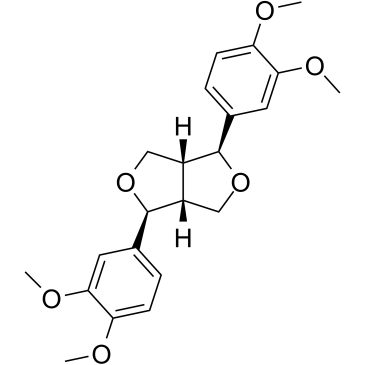
Pinoresinol dimethyl ether
CAS No. 29106-36-3
Pinoresinol dimethyl ether( —— )
Catalog No. M18374 CAS No. 29106-36-3
Pinoresinol dimethyl ether ((+)-Eudesmin) is a non-phenolic furofuran lignan isolated from the stem bark of Magnolia kobus with neuritogenic activity.
Purity : >98% (HPLC)
 COA
COA
 Datasheet
Datasheet
 HNMR
HNMR
 HPLC
HPLC
 MSDS
MSDS
 Handing Instructions
Handing Instructions
| Size | Price / USD | Stock | Quantity |
| 10MG | 90 | In Stock |


|
| 100MG | Get Quote | In Stock |


|
| 200MG | Get Quote | In Stock |


|
| 500MG | Get Quote | In Stock |


|
| 1G | Get Quote | In Stock |


|
Biological Information
-
Product NamePinoresinol dimethyl ether
-
NoteResearch use only, not for human use.
-
Brief DescriptionPinoresinol dimethyl ether ((+)-Eudesmin) is a non-phenolic furofuran lignan isolated from the stem bark of Magnolia kobus with neuritogenic activity.
-
DescriptionPinoresinol dimethyl ether ((+)-Eudesmin) is a non-phenolic furofuran lignan isolated from the stem bark of Magnolia kobus with neuritogenic activity. Pinoresinol dimethyl ether ((+)-Eudesmin) can induce neuritis outgrowth from PC12 cells by stimulating up-stream MAPK, PKC and PKA pathways.
-
In Vitro——
-
In Vivo——
-
Synonyms——
-
PathwayOthers
-
TargetOther Targets
-
RecptorOthers
-
Research Area——
-
Indication——
Chemical Information
-
CAS Number29106-36-3
-
Formula Weight386.44
-
Molecular FormulaC22H26O6
-
Purity>98% (HPLC)
-
SolubilityIn Vitro:?DMSO : 100 mg/mL (258.77 mM)
-
SMILESCOC1=C(C=C(C=C1)C2C3COC(C3CO2)C4=CC(=C(C=C4)OC)OC)OC
-
Chemical Name——
Shipping & Storage Information
-
Storage(-20℃)
-
ShippingWith Ice Pack
-
Stability≥ 2 years
Reference
molnova catalog



related products
-
SCPA
SCPA
-
Bovine Pineal Antire...
Threonyl-seryl-lysine, a bovine pineal antireproductive tripeptide, has antigonadotropic activity. Threonyl-seryl-lysine binds to luteinizing hormone-releasing hormone (LHRH) at a site comprised of LHRH 2-5.
-
GP2-114
GP2-114 is a catecholamine motility mimetic that produces current-dependent cardiovascular effects when administered via transdermal iontophoresis and can be used to study coronary artery disease (CAD).



 Cart
Cart
 sales@molnova.com
sales@molnova.com


